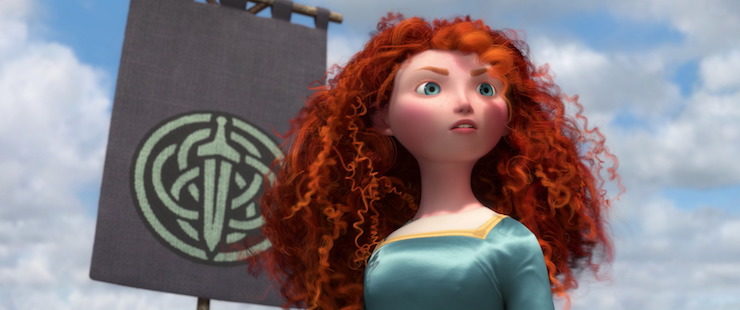By 2008, Pixar seemed to be well settled into the Disney family. So well settled, indeed, that Disney executives thought it would be a good idea for Pixar to strengthen those ties still further—by, say, doing something with one of Disney’s established franchises. Oh, not Winnie the Pooh or Disney Fairies. Those profitable franchises didn’t really need a new touch. But something that could use Pixar’s magical touch and creativity.
Say the Disney Princess franchise.
As it turned out, animator and director Brenda Chapman had already been, conveniently enough, musing about a story of a princess, her mother, and a bear. With just a few tweaks, it could easily be turned into a Disney Princess film.
And so, Pixar moved Brave into production.
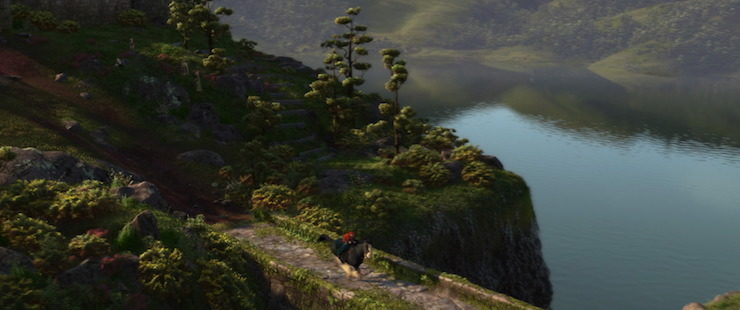
Brenda Chapman had previously worked for Disney on The Little Mermaid, Beauty and the Beast, and The Lion King, contributing to several books and interviews about the art of Disney as she did so. When Jeffrey Katzenberg took off in 1994 to form Dreamworks, Chapman went with him, working as a co-director on The Prince of Egypt and on story and animation for other Dreamworks films. In 2003 she headed to Pixar, working on several Pixar films before her idea for Brave was approved.
Two years after Brave was put into production, Chapman was removed from the film. Details remain vague. Pixar cited “creative differences,” and assured the media that Chapman was still an important part of the Pixar family—something that sounded rather unconvincing at the time, and sounded even less convincing when, the second that Brave was released, Chapman immediately headed to not-yet-owned-by-Disney Lucasfilm and later back to Dreamworks. Chapman also avoided giving details, merely saying that she was devastated. She later described the experience of watching someone else take over her ideas as heartbreaking, noted that her contract did not allow her to work on another film until after Brave was released, and added that she had no intentions of ever returning to Pixar.
It was left to someone with no direct connection to Pixar, Disney, or Dreamworks to provide a hint of the precise cause: Time’s Joel Stein, who, in an article written around Brave’s release date, memorably noted, “Until I visited Pixar, I did not know that 12-year-old boys were allowed to run major corporations.”
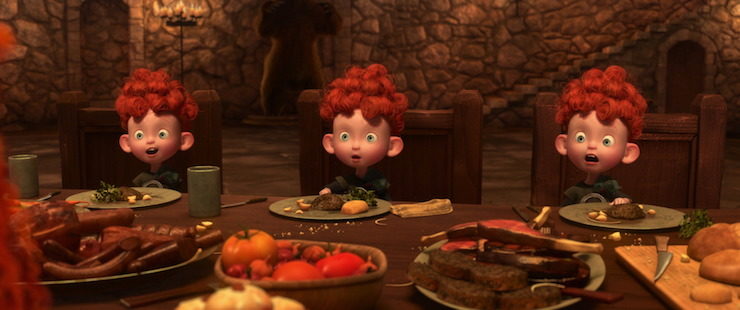
Stein was referring mostly to the sword fighting demonstrated for him within the studios, along with the individually decorated offices and the free cereal and the man in a kilt, apparently not a usual thing over at Time. But although Stein’s article did not discuss Chapman and her departure in particular, the sentence at least unwittingly hit upon a truth about Pixar made more public in 2017, when Chief Creative Officer John Lasseter announced that he would be taking a leave of absence from Disney: Pixar was, essentially, a boys club. A boys club that produced excellent films—but films where women and girls tended to be minor supporting characters at best, and barely appearing at worst (hi, Up!) It was perhaps not the easiest environment for a woman creating a film about a mother and a daughter, where men and boys would be minor supporting characters.
Whatever the reasons, with only two years left to work on the film, new director Mark Andrews had to scramble. He decided to cut a number of the snow scenes—scenes animators had been trying, with difficulty, to figure out how to animate. (The animators over on Frozen, coincidentally working on the same problem, hadn’t quite solved it by 2010.) He removed most of the magic, including a scene where summer shifted suddenly into winter (a fortunate change for Frozen, as it happened, which could then go ahead and have a similar scene do just that). Instead, he decided, Brave would be gloriously, beautifully green. Concerned that both of his main characters were coming off as distinctly unsympathetic, he chose to try to reframe certain scenes—including creating a sequence cutting between the complaints of Merida and her mother.
And he did all this while scrambling to stay on deadline—and use Pixar’s brand new animation system, Presto.
That final idea was not, by all accounts, his. Pixar had been using the same animation system for years, and although increased processing power had allowed for improvements, animators and programmers were in full agreement: the system needed an overhaul. Right then. No matter if the film was scrambling to stay on deadline. Unfortunately, Presto itself almost immediately needed an overhaul, given all of the inevitable early bugs, forcing Pixar to scramble still further.
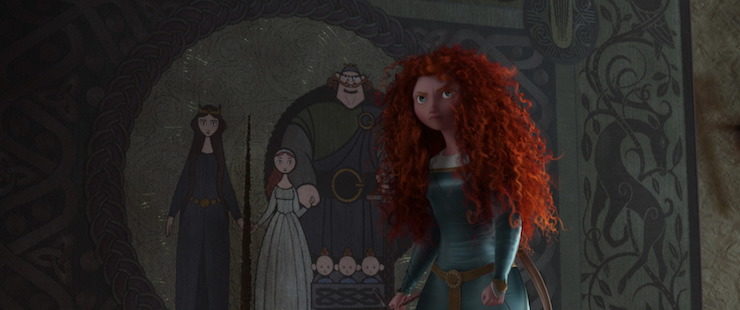
As all this was going on, Reese Witherspoon, who later noted that she had troubles developing the Scottish accent, had to abandon the role, to be replaced by actress Kelly Macdonald. Emma Thompson, the voice of Elinor, Merida’s mother, had a distinctly easier time of it. For the other roles, Pixar mostly stayed with Scots actors (with Billy Connolly and Robbie Coltrane particularly recognizable; Rome fans might also notice the familiar voice of Lucius sneaking into the film in a minor role. Two Americans—Pixar animator Steve Purcell, and Pixar staple John Ratzenberger—filled in bit parts. Scottish composer Patrick Doyle, responsible for the film’s score, and known for making brief cameos in films he scored, did so here as well.
Meanwhile, Pixar also needed to create an entirely fake Scottish culture—complete with four warring clans. Three of the clans were given somewhat Scottish sounding names—DunBroch, Dingwall and Macguffin—the last as a bit of an inside-movie joke referring to “Macguffins”—objects created as plot devices to motivate characters. (Brave itself has one or two Macguffins.) That was apparently all of the creativity that the stressed animators and writers could handle: for the last Scottish clan, they went with “Macintosh.” Perhaps not surprisingly, the final film features a lot of apples. The three new fake clans also needed new tartans, while the real Macintosh tartan had to be tweaked for the film. Pixar ended up registering that tartan officially—the second time a Disney company or subsidiary had registered a Scottish tartan.
(That’s right: Clan MacDuck has an Official Tartan in the official Scottish Register of Tartans; the pattern was originally used to help sell warbonds during World War II. And you thought Donald Duck spent his war years just quacking and making occasional trips down to Latin America to chase women.)
Perhaps not surprisingly after all of this, not to mention four separate credited screenwriters, Brave ended up as a bit of a narrative mess.
Oh, the results look spectacular. I’m getting almost tired of saying this with every Pixar film, but robbed of dialogue and music and just judged as a computer-generated painting, nearly every shot here is an individual work of art, with the scenes of Merida exploring Scotland, Merida following the will o’ wisps, and the sequence of Merida and her mother (in bear form) creeping through the fog as particular highlights. I could just stare at many of these scenes all day.
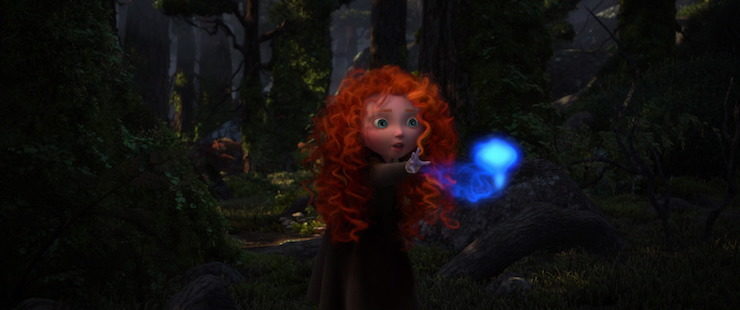
Unfortunately, the beauty doesn’t counter the many and varied problems with the characters and the plot. It’s not that the plot is bad, exactly: Little Merida is more interested in adventure and archery than traditional “princess” activities like embroidery and music, a feeling that only grows stronger when Merida becomes a teenager. It doesn’t help that, as a short scene demonstrates, she’s abysmal at the music—in a culture otherwise filled with joyful, rambunctious singing and playing. This brings her into ongoing conflict with her more traditionally minded, frequently abstracted mother, Elinor, who wants Merida to be a traditional princess and marry one of the three egregiously awful sons of the three other clan leaders, insisting on this even after Merida wins an archery competition for her hand.
An infuriated Merida follows some lovely little will o’ wisps off to the home of a witch who really just wants to be a woodcarver (this is great) and is desperate for some customers (also great). A witch who really, truly, does not want to be a witch and tries to warn customers off her magical products is a rare thing in Disney films and in films in general, and I really wish the film had explored this more. But no: Merida is insistent, and the film is in a hurry, so she gets her spell and rushes home.
Here, things are going poorly, with everyone drunk, fighting, and increasingly irritated. Still, Merida manages to feed her mother some cake—which, instead of convincing her mother to give up the whole marriage idea, turns her mother into a bear. This is not, frankly, something that her mother is very good at—she is freaked out by the idea of being naked (an idea that, also frankly, this film spends a surprising amount of time on) finally allowing her daughter the chance to shine, and for the two to begin to appreciate each other, with Elinor realizing her daughter’s good qualities, and Merida remembering happier times with her mother, and her mother’s many kindnesses.
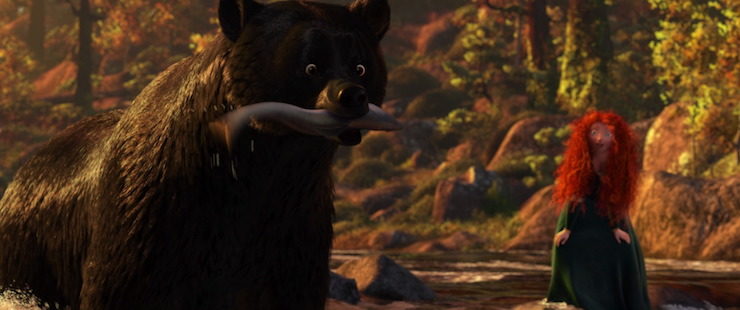
Alas, before all of this can be used to un-transform her mother, they have to deal with a haunted bear.
The film frequently lurches between one plot to another, never entirely sure what it’s about: Merida and her mother (as most of the film suggests), or about the need to be yourself (as the marketing campaign and some of Merida’s dialogue would suggest), or about the need to rid the kingdom of an evil, haunted bear (as the opening sequence and the second half of the film suggest)?
Nor are Merida and Elinor overly sympathetic– partly thanks to the film’s tendency to hold off on some rather important revelations until way too late in the film. For instance, Brave only bothers to explain just why the Queen—and indeed, pretty much everyone else except for the Merida and the triplets—is so frantic about this marriage: it’s meant to seal a fragile alliance between the clans, and provide a defense against the Vikings. Information that would have been rather interesting to know earlier in the film, when Elinor looked like a parent forcing a child into an unwanted role for no particular reason—and information that makes Merida, in retrospect, look even more self-absorbed. It doesn’t help that right after this revelation, everyone agrees that they don’t need the marriage after all—making me think that for all of the “If she would just LISTEN!” shouted by several characters throughout the film, what was actually needed was “IF SHE WOULD JUST TALK!”
That said, Merida’s rudeness towards her suitors is a bit difficult to take too seriously in an environment where pretty much no one except the queen, and I suppose arguably Maudie the maid, is bothering to follow any sort of protocol or basic manners. The queen allows the triplets to run around completely unsupervised, and as a result, the triplets spend their time playing tricks and stealing cakes and other things. As it turns out, there’s a plot reason for this—the film needs to establish why nobody would notice or worry about their later disappearance, but their earlier activities, combined with the Queen’s insistence that Merida spend time on tasks the girl is obviously unsuited for, does not exactly paint a picture of competent motherhood.
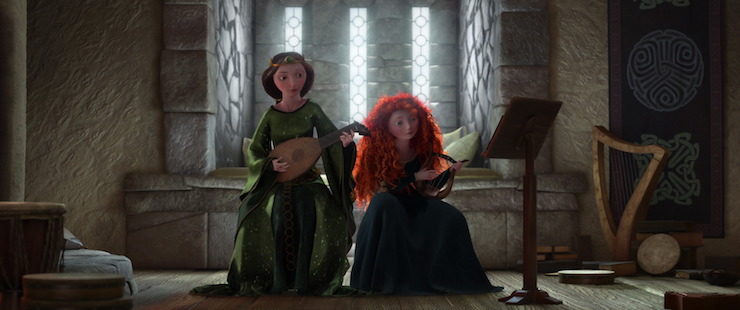
Still, despite her issues with her mother, Merida initially comes off as considerably less sympathetic than virtually any other Disney Princess—particularly the other Disney Princesses told to accept unwanted (usually gendered) expectations, such as Ariel, Jasmine, and Mulan. Unlike Jasmine, who has been trapped behind palace walls all her life, and appears to have no friends other than a tiger, Merida leaves her castle on a regular basis, riding her horse and going rock climbing, and appears to be on at least relatively decent terms with the castle folk. Granted, all of that seems to me more of an excuse for Pixar to show off its latest upgrade to its rendering software, using techniques that would later be used to equally astonishing effect in scenes in Frozen, but, still. She’s getting to rock-climb. And although Jasmine and her tiger don’t hesitate to reject suitor princes in a humiliating fashion, they don’t do so as publicly as Merida does. Unlike Mulan, Merida thinks mostly of what she wants, not of saving her family.
And very much unlike Ariel, who asks for a spell to transform herself, Merida asks for a spell to transform someone else. Ariel also sticks around to hear the conditions of the spell; Merida rushes off—only finding out the terms after several valuable hours have passed, increasing the risk. And Ariel is assured—not, admittedly, all that convincingly—that Ursula is only concerned with helping Poor Unfortunate Souls. Merida is flat out warned by the witch that her last spell did not go well.
And yet.
On the other hand, by accepting magical assistance from a clearly questionable source—in this case, a witch who admits that she’s given up witchcraft thanks to “too many dissatisfied customers”—Merida does fit right into the Disney Princess tradition. So there’s that.
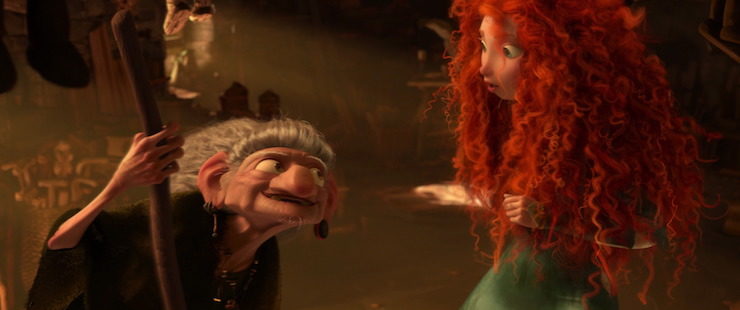
In one way, of course, Merida represented an important turning point for the Disney Princess franchise: the first Disney Princess without a romance or even the mere hint of a romance. Even Pocahontas, the only other Disney Princess before Brave to end up single, at least had enjoyed a romance, of sorts, if an unusually doomed one for a Disney film. (Disney was also hampered by some actual history in that case, even if they generally ignored said history.) Merida is the first thoroughly unromantic Disney princess—setting the stage for Elsa and Moana.
At the same time, in some ways Merida represented a step backwards for the Disney Princess franchise, in that, rather than presenting a new take on the Disney Princess concept, her goals and methods are strikingly similar to that of Ariel, Jasmine, Pocahontas, and Mulan. The effect unfortunately, is to leave Brave as the one Disney Princess film that doesn’t really add anything new to the Disney Princess line—in direct contrast to nearly every other Disney Princess. In particular, to her immediate predecessor, Tiana, the first Disney Princess with a professional goal that she was willing to work hard for. It all suggests that Brave might have done better as a non-Disney Princess film, one focused on whatever its original plot was—without the influences of the earlier Disney films.
I have a number of other questions. Why, exactly, do Disney Princesses continue to accept magical help from clearly questionable magical sources? Did the king really not visit his wife’s bedroom even once during the night she was a bear? No one noticed that the three princes were missing, or that three little bear cubs were wandering around the castle? Is Merida bothered not just by the endless princess lessons, but also by the fact that her brothers are not required to follow the same lessons—or indeed, apparently any lessons or discipline at all? Did the will o’ wisps, which initially appear to Merida when she was a young child, want Merida to conquer the bear the whole time? If so, why force Merida—and Elinor—through such a complicated process?
And one more minor point: One of Merida’s suitors only speaks what Disney assures me is Doric, a dialect of Scots, which none of the characters in the film understand. This puzzles me: I get why American viewers would be unable to understand Scots dialects (or even some Scots accents), but surely, a few of these kilts-wearing Scots would be at least able to understand the general gist? And if no one can understand him, how did he learn this dialect in the first place? It’s a lot of work for a joke that falls relatively flat, and just one more element that really doesn’t make all that much sense.
It all leaves Brave, despite its beauty, as one of the weakest Pixar films.
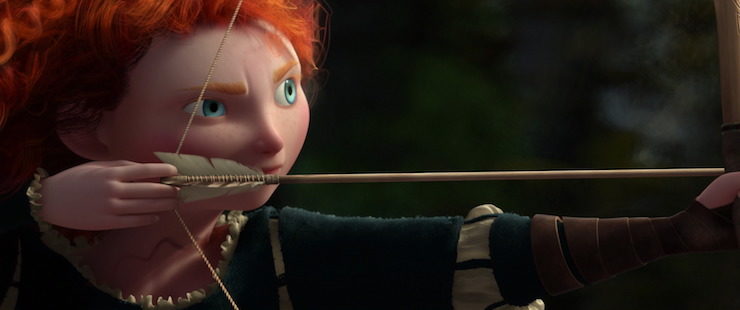
Nonetheless, Brave did decently at the box office, bringing in a solid $540.4 million. Merida merchandise was rushed into stores as Merida officially joined the Disney Princess line. The crowning did not go quite without controversy, as Disney briefly released a skinnier Merida with slimmer hair, a decision the company swiftly retreated from: all later Merida merchandise stayed with the original image of an already fairly skinny Merida from the film. Said merchandise included clothing, dolls, tea sets, T-shirts and far more. The film earned multiple accolades from critics and took home the Academy Award for Best Animated Feature. A live action version of Merida was later featured on ABC’s Once Upon a Time. On the surface, at least, Brave was a success.
And yet. For whatever reason, Merida never seemed to gain the popularity of her fellow Disney Princesses. Merida merchandise is often missing from Disney stores, or kept on lower shelves. This may have been because Disney already had a rather self-centered, rebellious, red-headed princess in Ariel, or because Disney already had a fighting warrior princess in Mulan, or simply because Brave had only one year to establish itself before Frozen came along with Elsa and Anna. Or perhaps—just perhaps—viewers were responding to something else in the film. Something lacking.
Pixar did not waste time worrying about it. They had another film to finish up—this one heading back to one of their established successes.
Monster University, coming up next month.
Mari Ness lives in central Florida.










